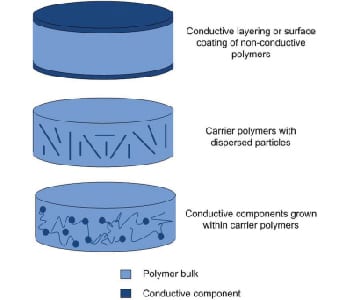A soft, implantable, conductive material remains an elusive challenge for biomedical engineers. Such a material has applications in almost all excitable tissues within the body – ranging from bionic devices to cardiac patches and spinal cord repair. A number of component materials and fabrication methods have been explored as researchers seek to create materials that are biocompatible and can communicate with nervous tissue in the human body. To achieve such a material it is necessary to combine electrically conductive materials that are often hard or brittle with softer, more compliant non-conductive polymers. Different mechanisms for imparting conductivity to non-conductive polymeric biomaterials are discussed in a review by Patton et. al.
A simple approach is to create a conductive layer overlying a non-conductive polymer. Using this approach, the base material can be fabricated in a wide range of forms, from flat sheets to complex 3D shapes. The polymer form can then be coated with a conductive component, such as a metal, carbon nanotubes or inherently conductive polymer. While this approach maintains a high degree of control over the mechanics of the material, it leads to poor integration and often delamination of the two  components.
components.
Pre-fabricated conductive materials produced as particles can be added to polymer solutions or melts during fabrication to produce a polymer in which conductive particles are dispersed. The conductive component needs to be incorporated at sufficiently high percentages (known as the percolation threshold) to support electrical charge passage through the material. The addition of such particles above a threshold level often impacts the mechanical properties of the material. It has been found that a trade-off between conductivity and elasticity is often required.
A more recent method for production of soft conductive materials is the growth of a conductive component within a bulk non-conductive polymer. This method presents the opportunity to improve integration of the conductive and non-conductive components and support better mechanical and electrical properties. Using this approach, freestanding soft electrode materials that are not reliant on metal electrodes can be produced. This has significant potential for future implantable electronic devices that do not contain metals.

















